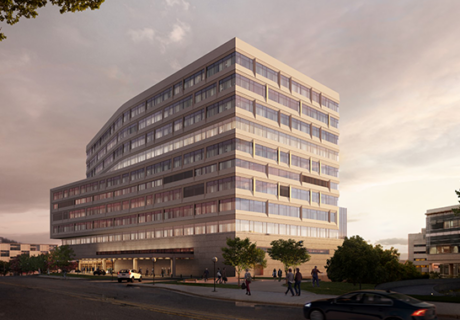Designing for the (Bariatric) Population
Healthcare designers today must take into consideration more factors than ever when designing hospital spaces. Among a number of issues, two topics consistently enter into the discussion during initial meetings with clients planning renovations or new construction at their acute care facility.
The first centers on ensuring that the design creates a healing, supportive environment for patients, families, and staff. The second point involves the need to accommodate bariatric patients and family members.
The need to develop spaces that meet both priorities—creating a supportive environment and accommodating bariatric individuals—presents a new and exciting opportunity to change the way interior designers, healthcare professionals, and product manufacturers think about meeting the needs of size-challenged individuals.
Practically every hospital building project today seeks to create a healing environment, led primarily by the efforts of The Center for Health Design to create awareness about the role that architecture and design play in enhancing the quality of healthcare delivery.
To achieve a soothing aesthetic, features such as natural light, nature views (gardens, water), comfortable furniture, woven walls, uplifting colors, and tranquil artwork are among a number of increasingly common design elements found in hospitals. Each of these work together to give facilities a softer look and feel, and help to reduce stress for patients, their loved ones, and hospital employees.
(For more on designing for a bariatric population, see “Bariatric Design Trends In Healthcare.”)
Designing healthcare spaces for bariatric patients
While the design elements outlined above remain the same when creating healing environments for any group of patients, designing spaces that are supportive of bariatric individuals requires additional considerations. Special attention must be given to meeting the psychological and physical needs of bariatric patients and their families.
The reason healthcare professionals and designers put a great deal of emphasis on planning facilities to serve obese visitors is evident in recent national statistics. The Centers for Disease Control and Prevention (CDC) defines obesity as a Body Mass Index—or a measure of an adult’s weight in relation to his or her height—of 30 or higher. In 1990, no states in the Behavioral Risk Factor Surveillance System reported obesity prevalence equal to or greater than 15% of the population. By contrast, during 2006 only four states had a prevalence of obesity at less than 20%.
Nationally, these figures translate into 34% of U.S. adults aged 20 and over, or more than 72 million people, classified as obese. With the obesity rate rising so quickly among the U.S. population, designers and healthcare providers must plan now to meet the needs of this segment in the future.
The discussion about how bariatrics fits into the design of a hospital often begins with a very practical question: how much space in any given area of a facility should be devoted to accommodating size-challenged patients and visitors? While a variety of accepted standard practices exists, such as committing 10-20% of a facility’s seating to meeting bariatric needs, a new answer is emerging.
Specifically, there’s a need to shift the thinking beyond merely allocating a certain percentage of space to bariatric patients and focus instead on an approach that takes into consideration the needs of all patients and family members, regardless of body shape or weight.
Universal design in healthcare
The idea is that design solutions should emphasize the similarities among people rather than draw attention to their differences. One of the ways this may be accomplished is by designing spaces and furnishings that don’t look as if they were developed specifically for the size-challenged segment of the population. Other means include providing design cues and details that are fashionable and follow current furnishing trends.
Designing spaces that are more universal in nature—as opposed to creating entirely separate spaces and products for people of average size and those who are obese—involves a number of different design elements. Lobby and patient room furniture, for example, can serve as a key component in establishing an environment that avoids segregating the size-challenged from average-sized people.
Much of today’s bariatric seating represents larger versions of standard products. However, new offerings will take into consideration the psychosocial needs and physical requirements of obese individuals as well as the interests of interior designers in achieving a consistent look throughout a facility.
The universal approach even extends to practical considerations such as floor lifts. As another way of ensuring that a patient room supports the needs of both average weight and obese patients, more patient rooms include portable floor lifts that can accommodate patients up to 1,000 pounds. These systems enable the safe mobility and transfer of patients as they move through a facility, without having to dedicate specific rooms for bariatric patients or limit the patient care process.
To further support a universal approach to spaces that work for people of all shapes and sizes, products in patient rooms need to feature simple functionality. Doing so makes products easier to use for staff, an important consideration in allowing nurses to spend more time on patient care.
Design research shows that careful planning in interior design can help create healing environments that improve healthcare delivery and the overall hospital experience for patients, families, and staff. With more than one-third of adults in the United States classified as obese, healthcare facility designers will focus more than ever on accommodating this segment of the population. Creating spaces and products that can equally serve both average and size-challenged individuals will provide all patients and families with the dignity, respect, and compassion that they deserve. HD
Kristen DelGandio, IIDA, is Senior Interior Designer at Wilmot Sanz Inc.



